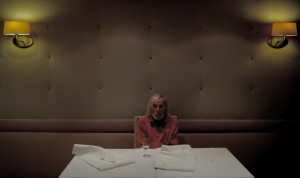Vader is set in the visiting area of an old-folks home whose towering walls accentuate the fact that the action takes place deep underground. At the centre of this netherworld, somewhere between the world of the living and the dead, stands the figure of the father, who seems to be distancing himself gradually from the human community. His fading is drawn, not from the story of one individual, but from the mythology of the father, and in scenes that explode into action, and just as suddenly stop, this figure appears at once as God-like and ridiculous, as possessed of a rich mental life, and as disconnected, decaying, empty. His past may harbour a deep secret, or maybe he is simply mad or delusional. The other residents and the staff wonder at him, regarding him with amusement and hatred, affection and indifference. The piece plays on the widening gap between perception and reality, on the way time for the old appears to slow down so as to correspond to the lagging rhythm of their gestures, or articulate speech is received as static and music as noise, or the world itself seems to make sense only insofar as it is the embodiment of a memory. With poignancy and wit, Vader explores the moment when the memories (or are they fancies, hallucinations?) of an old man, a sort of latter-day Don Quixote, constantly threaten to tip the realities of daily life into fantasy.



